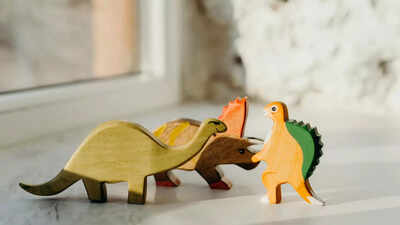Trending
Fossilized poop reveals secrets of how dinosaurs came to dominate Earth
Scientists have unlocked the mystery of why dinosaurs took 30 million years to dominate Earth by studying fossilized poop. By analyzing undigested food and prey remains, researchers have determined that the dietary diversity and adaptability of dinosaurs played a key role in their evolutionary success during the Late Triassic period.

A recent study that analyzed the fossilized poop and vomit (known scientifically as coprolites and bromalites) has uncovered a key factor in their evolutionary success: their diet. The findings have been published in the journal Nature.
“Piecing together ‘who ate whom’ in the past is true detective work,” Martin Qvarnström, a researcher at the Department of Organismal Biology and lead author of the study said in a statement. He added, “Being able to examine what animals ate and how they interacted with their environment helps us understand what enabled dinosaurs to be so successful.”

(Pic courtesy: Pexels)
By identifying undigested food, plants, and prey, they reconstructed the structure of the ecosystems from the time dinosaurs began to thrive. The study focused on the Polish Basin in the
Late Triassic period, part of the northern supercontinent Pangea. Combining coprolite findings with climate data and other fossils such as plants, bite marks, vomit, footprints, and bones, the researchers developed a comprehensive picture of the Triassic and Jurassic ecosystems (from about 230 to 200 million years ago).
“The research material was collected over a period of 25 years. It took us many years to piece everything together into a coherent picture,” Grzegorz Niedźwiedzki, a researcher at the Department of Organismal Biology and the study’s senior author said in a release. “Our research is innovative because we have chosen to understand the biology of early dinosaurs based on their dietary preferences. There were many surprising discoveries along the way.”

(Pic courtesy: Pexels)
The fossilized poop contained remains of fish, insects, larger animals, and plants, some of which were unusually well preserved, including small beetles and semi-complete fish.
In other poop samples, they found chewed-up bones indicating that predators, similar to modern-day hyenas, crushed bones to access salts and marrow. The content of poop from the first large herbivorous dinosaurs, the long-necked sauropods, was surprising for the researchers, as it had large quantities of tree ferns, other types of plants, and charcoal. Paleontologists came to the hypothesis that charcoal was ingested to detoxify stomach contents, as ferns can be toxic to herbivores.
The study also addressed a significant gap in current knowledge: the first 30 million years of dinosaur evolution during the Late Triassic period. The researchers stressed the fact that understanding how the first dinosaurs achieved their success can offer valuable insights into prehistoric ecosystems and evolutionary processes in general. According to the findings, dietary diversity and adaptability were crucial survival traits during the environmental changes of the Late Triassic.

(Pic courtesy: Pexels)
“Unfortunately, climate change and mass extinctions are not just a thing of the past. By studying past ecosystems, we gain a better understanding of how life adapts and thrives under changing environmental conditions,” Qvarnström added.
“The way to avoid extinction is to eat a lot of plants, which is exactly what the early herbivorous dinosaurs did. The reason for their evolutionary success is a true love of green and fresh plant shoots,” Niedzwiedzki concluded.
(Pic courtesy: Pexels)
End of Article
FOLLOW US ON SOCIAL MEDIA








